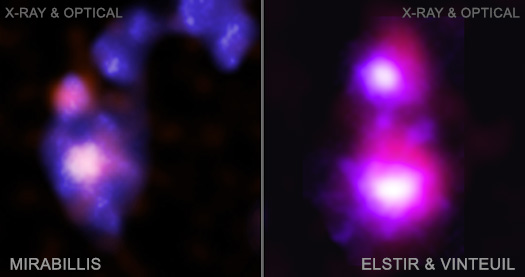Chandra's Indirect Glance into the Early Universe: Merging Dwarf Galaxies and their AGN
We are pleased to welcome Marko Mićić as a guest blogger. Marko led the study that is the subject of our latest press release [link to PR]. He graduated from the University of Belgrade, Serbia, with a degree in Astronomy and Astrophysics, in 2018. The same year he started a Ph.D. at the University of Alabama, and has been working under Dr. Jimmy Irwin's supervision since then. His research interests include evolution of low-mass galaxies, AGN content of low-mass galaxies, intermediate-mass black holes and gravitational lenses.
Galaxies are made up of billions of stars, interstellar gas and dust, and large amounts of dark matter. Every (or almost every) galaxy is expected to host a supermassive black hole in its center. Galaxies and their central black holes grow and evolve together predominantly through mergers; smaller objects merge to create larger ones over time. However, the earliest stages of galaxy evolution involving the mergers of the first galaxies are poorly understood. It is unclear how the first mergers affected the morphology of ancient galaxies and their star formation. We also do not know how massive the first black holes were that inhabited the first galaxies, nor how the first mergers influenced their ability to accrete – pull in – material.
It is challenging to answer these important questions because the first mergers are too distant and faint to be directly observed. One way to overcome this issue is to look for local analogs. In other words, we need to find pairs of small, dwarf galaxies that have had very quiet lives, with almost no mergers, that have only recently met and started interacting. Such galaxies have experienced little to no evolution so they are analogs of distant, ancient galaxies, and observations of their mergers would represent the local case study that illustrates the hierarchical growth of structures in the early Universe. Their central black holes are also expected not to have grown much and preserve information about primordial seeds, potentially holding the key to resolving the outstanding problem of the origin of supermassive black holes.
Not much work has been done on dwarf-dwarf galaxy mergers, and only a small number of them have been discovered. Furthermore, detecting a black hole in a dwarf galaxy is extremely challenging. The only feasible way to do so is by detecting signs of ongoing accretion. As material spirals into the black hole it forms the accretion disk, heats up, and emits radiation which can be detected using X-ray observatories. Such an actively accreting black hole is usually called an active galactic nucleus (AGN). However, even this approach has associated problems since AGN in dwarf galaxies are expected to be faint in X-rays, and typically require hundreds of thousands of seconds of observing time to detect them even at modest distances. Consequently, the evidence for the existence of AGN in dwarf-dwarf mergers is extremely scarce.
Mirabilis, Elstir and Vinteuil. (More images...)
We decided to tackle this problem by undertaking the first large-scale project to search for AGN in dwarf-dwarf galaxy mergers. We used deep, archival Chandra X-ray and WISE infrared observations to assess the AGN candidacy and search for specific signatures of black hole accretion. We particularly focused on close pairs of AGN, so called dual AGN. Once we compiled a large sample of potential dual AGN, we needed to examine whether they are just chance-aligned background or foreground unrelated objects, or genuine pairs of AGN. For that purpose we analyzed optical, archival images taken with the Canada-France-Hawaii telescope. We studied properties of the galaxies hosting potential dual AGN and we looked for evidence that galaxies are in the process of interaction. Interacting galaxies often develop a variety of tidal debris features, such as tidal tails, bridges, or shells, and detecting structures of that kind would be a strong indicator that galaxies are merging and that previously detected potential AGN pairs are bona fide dual AGN. Since tidal debris around dwarf galaxies is expected to be faint, we applied careful image processing on optical images to enhance their quality, which allowed us to reveal structures that would have been undetectable otherwise.
This approach turned out to be successful, and two undergraduate students working on this project – Olivia Holmes and Brenna Wells, both from University of Alabama – found the two candidates for dual AGN in dwarf-dwarf galaxy mergers, the first objects of their kind ever discovered. We named the first of them Mirabilis. According to the works from the literature, Mirabilis is around 760 million light-years away, which makes it a very small and faint dwarf galaxy. It contains a long, clumpy tidal tail, and a smaller countertail, forming a rough S shape, the typical signature of an ongoing galaxy merger. The main galaxy and one of the clumps from the long tail contain Chandra- and WISE-detected AGN-like sources. We are likely observing the late stage of a merger, and the long, clumpy tail is a remnant of an even smaller dwarf galaxy that got completely disrupted by the gravitational forces of its more massive neighbor. The second candidate consists of two dwarfs that we named Elstir and Vinteuil, which are likely to be around 3.2 billion light-years away. Both galaxies are smaller and less luminous than an average galaxy, and their properties are more in line with local dwarf galaxies. They are connected by a long tidal bridge. Elstir and Vinteuil are likely in an early stage of merging, and Elstir is stripping material from Vinteuil. Both galaxies contain Chandra- and WISE-detected AGN-like sources. The work is in progress as we have more data to go through, and we anticipate more similar discoveries.
In order to better understand the earliest stages of hierarchical growth of black holes and galaxies, and to confirm the dwarf nature of the galaxies, we need new follow-up observations. We have already obtained spectroscopic – involving the study of the amount of light at different wavelengths – and radio observations. Spectroscopic observations will provide accurate measurements of the distance, mass, and metallicity of the galaxies, while radio observations will help solidify the AGN scenario and help estimate the masses of the black holes powering the AGN, using known relationships between the X-ray and radio brightness and the mass of black holes. Existing data and observations, along with observations we plan to obtain in the future, will allow us to indirectly peer back into time and study the key processes that govern the earliest stages of the evolution of galaxies and black holes; processes that remained hidden from us until now.


